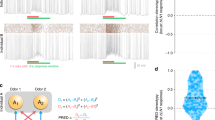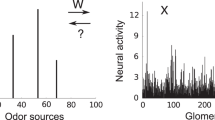Abstract
In the mushroom body of insects, odors are represented by very few spikes in a small number of neurons, a highly efficient strategy known as sparse coding. Physiological studies of these neurons have shown that sparseness is maintained across thousand-fold changes in odor concentration. Using a realistic computational model, we propose that sparseness in the olfactory system is regulated by adaptive feedforward inhibition. When odor concentration changes, feedforward inhibition modulates the duration of the temporal window over which the mushroom body neurons may integrate excitatory presynaptic input. This simple adaptive mechanism could maintain the sparseness of sensory representations across wide ranges of stimulus conditions.
This is a preview of subscription content, access via your institution
Access options
Subscribe to this journal
Receive 12 print issues and online access
$209.00 per year
only $17.42 per issue
Buy this article
- Purchase on Springer Link
- Instant access to full article PDF
Prices may be subject to local taxes which are calculated during checkout








Similar content being viewed by others
References
Gross-Isseroff, R. & Lancet, D. Concentration-dependent changes of perceived odor quality. Chem. Senses 13, 191–204 (1988).
Bhagavan, S. & Smith, B.H. Olfactory conditioning in the honey bee, Apis mellifera: effects of odor intensity. Physiol. Behav. 61, 107–117 (1997).
Stopfer, M., Jayaraman, V. & Laurent, G. Intensity versus identity coding in an olfactory system. Neuron 39, 991–1004 (2003).
Laurent, G. Olfactory network dynamics and the coding of multidimensional signals. Nat. Rev. Neurosci. 3, 884–895 (2002).
Kanerva, P. Sparse Distributed Memory, (Bradford Books, Boston, 1988).
Olshausen, B.A. & Field, D.J. Sparse coding of sensory inputs. Curr. Opin. Neurobiol. 14, 481–487 (2004).
Wehr, M. & Laurent, G. Odour encoding by temporal sequences of firing in oscillating neural assemblies. Nature 384, 162–166 (1996).
Laurent, G., Wehr, M. & Davidowitz, H. Temporal representations of odors in an olfactory network. J. Neurosci. 16, 3837–3847 (1996).
Perez-Orive, J. et al. Oscillations and sparsening of odor representations in the mushroom body. Science 297, 359–365 (2002).
Perez-Orive, J., Bazhenov, M. & Laurent, G. Intrinsic and circuit properties favor coincidence detection for decoding oscillatory input. J. Neurosci. 24, 6037–6047 (2004).
Pouille, F. & Scanziani, M. Enforcement of temporal fidelity in pyramidal cells by somatic feedforward inhibition. Science 293, 1159–1163 (2001).
Mittmann, W., Koch, U. & Hausser, M. Feedforward inhibition shapes the spike output of cerebellar Purkinje cells. J. Physiol. (Lond.) 563, 369–378 (2005).
Anton, S. & Homberg, U. Antennal lobe structure. in Insect Olfaction (ed. Hansson, B.S.) (Springer, Berlin, 1999).
Matthews, H.R. & Reisert, J. Calcium, the two-faced messenger of olfactory transduction and adaptation. Curr. Opin. Neurobiol. 13, 469–475 (2003).
Anderson, P., Hansson, B.S. & Löfqvist, J. Plant-odour–specific receptor neurones on the antennae of female and male Spodoptera littoralis. Physiol. Entomol. 20, 189–198 (1995).
Hallem, E.A. & Carlson, J.R. Coding of odors by a receptor repertoire. Cell 125, 143–160 (2006).
Hallem, E.A., Ho, M.G. & Carlson, J.R. The molecular basis of odor coding in the Drosophila antenna. Cell 117, 965–979 (2004).
Ernst, K.D., Boeckh, J. & Boeckh, V. A neuroanatomical study on the organization of the central antennal pathways in insects. Cell Tissue Res. 176, 285–306 (1977).
MacLeod, K., Backer, A. & Laurent, G. Who reads temporal information contained across synchronized and oscillatory spike trains? Nature 395, 693–698 (1998).
MacLeod, K. & Laurent, G. Distinct mechanisms for synchronization and temporal patterning of odor-encoding neural assemblies. Science 274, 976–979 (1996).
Laurent, G. & Davidowitz, H. Encoding of olfactory information with oscillating neural assemblies. Science 265, 1872–1875 (1994).
Bazhenov, M. et al. Model of cellular and network mechanisms for odor-evoked temporal patterning in the locust antennal lobe. Neuron 30, 569–581 (2001).
Bazhenov, M. et al. Model of transient oscillatory synchronization in the locust antennal lobe. Neuron 30, 553–567 (2001).
Margrie, T.W., Sakmann, B. & Urban, N.N. Action potential propagation in mitral cell lateral dendrites is decremental and controls recurrent and lateral inhibition in the mammalian olfactory bulb. Proc. Natl. Acad. Sci. USA 98, 319–324 (2001).
Jortner, R.A., Farivar, S.S. & Laurent, G. A simple connectivity scheme for sparse coding in an olfactory system. J. Neurosci. 27, 1659–1669 (2007).
Mazor, O. & Laurent, G. Transient dynamics versus fixed points in odor representations by locust antennal lobe projection neurons. Neuron 48, 661–673 (2005).
Marr, D. A theory of cerebellar cortex. J. Physiol. (Lond.) 202, 437–470 (1969).
Salinas, E. & Sejnowski, T.J. Impact of correlated synaptic input on output firing rate and variability in simple neuronal models. J. Neurosci. 20, 6193–6209 (2000).
Stopfer, M., Bhagavan, S., Smith, B.H. & Laurent, G. Impaired odour discrimination on desynchronization of odour-encoding neural assemblies. Nature 390, 70–74 (1997).
Konig, P., Engel, A.K. & Singer, W. Integrator or coincidence detector? The role of the cortical neuron revisited. Trends Neurosci. 19, 130–137 (1996).
Hopfield, J.J. Pattern recognition computation using action potential timing for stimulus representation. Nature 376, 33–36 (1995).
Buzsaki, G. Feedforward inhibition in the hippocampal formation. Prog. Neurobiol. 22, 131–153 (1984).
Blitz, D.M. & Regehr, W.G. Timing and specificity of feed-forward inhibition within the LGN. Neuron 45, 917–928 (2005).
Sun, Q.Q., Huguenard, J.R. & Prince, D.A. Barrel cortex microcircuits: thalamocortical feedforward inhibition in spiny stellate cells is mediated by a small number of fast-spiking interneurons. J. Neurosci. 26, 1219–1230 (2006).
Destexhe, A., Mainen, Z.F. & Sejnowski, T.J. Synthesis of models for excitable membranes, synaptic transmission and neuromodulation using a common kinetic formalism. J. Comput. Neurosci. 1, 195–230 (1994).
Wilson, R.I. & Laurent, G. Role of GABAergic inhibition in shaping odor-evoked spatiotemporal patterns in the Drosophila antennal lobe. J. Neurosci. 25, 9069–9079 (2005).
Rulkov, N.F., Timofeev, I. & Bazhenov, M. Oscillations in large-scale cortical networks: map-based model. J. Comput. Neurosci. 17, 203–223 (2004).
Bazhenov, M., Rulkov, N.F., Fellous, J.M. & Timofeev, I. Role of network dynamics in shaping spike-timing reliability. Phys. Rev. E 72, 041903 (2005).
Bazhenov, M., Stopfer, M., Sejnowski, T.J. & Laurent, G. Fast odor learning improves reliability of odor responses in the locust antennal lobe. Neuron 46, 483–492 (2005).
Laurent, G. Dynamical representation of odors by oscillating and evolving neural assemblies. Trends Neurosci. 19, 489–496 (1996).
Wehr, M. & Laurent, G. Relationship between afferent and central temporal patterns in the locust olfactory system. J. Neurosci. 19, 381–390 (1999).
Laurent, G. & Naraghi, M. Odorant-induced oscillations in the mushroom bodies of the locust. J. Neurosci. 14, 2993–3004 (1994).
Stopfer, M. & Laurent, G. Short-term memory in olfactory network dynamics. Nature 402, 664–668 (1999).
Acknowledgements
This work was supported by grants from the US National Institute of Deafness and other Communication Disorders (C.A., G.L. and M.B.), the National Science Foundation (G.L.) and a US National Institute of Child Health and Human Development intramural award (M.S.).
Author information
Authors and Affiliations
Corresponding author
Ethics declarations
Competing interests
The authors declare no competing financial interests.
Rights and permissions
About this article
Cite this article
Assisi, C., Stopfer, M., Laurent, G. et al. Adaptive regulation of sparseness by feedforward inhibition. Nat Neurosci 10, 1176–1184 (2007). https://doi.org/10.1038/nn1947
Received:
Accepted:
Published:
Issue Date:
DOI: https://doi.org/10.1038/nn1947
This article is cited by
-
Oscillatory integration windows in neurons
Nature Communications (2016)
-
Sparse, decorrelated odor coding in the mushroom body enhances learned odor discrimination
Nature Neuroscience (2014)
-
Effect of GABAergic inhibition on odorant concentration coding in mushroom body intrinsic neurons of the honeybee
Journal of Comparative Physiology A (2014)
-
A model of non-elemental olfactory learning in Drosophila
Journal of Computational Neuroscience (2012)
-
Dynamics of sensory processing in the dual olfactory pathway of the honeybee
Apidologie (2012)



